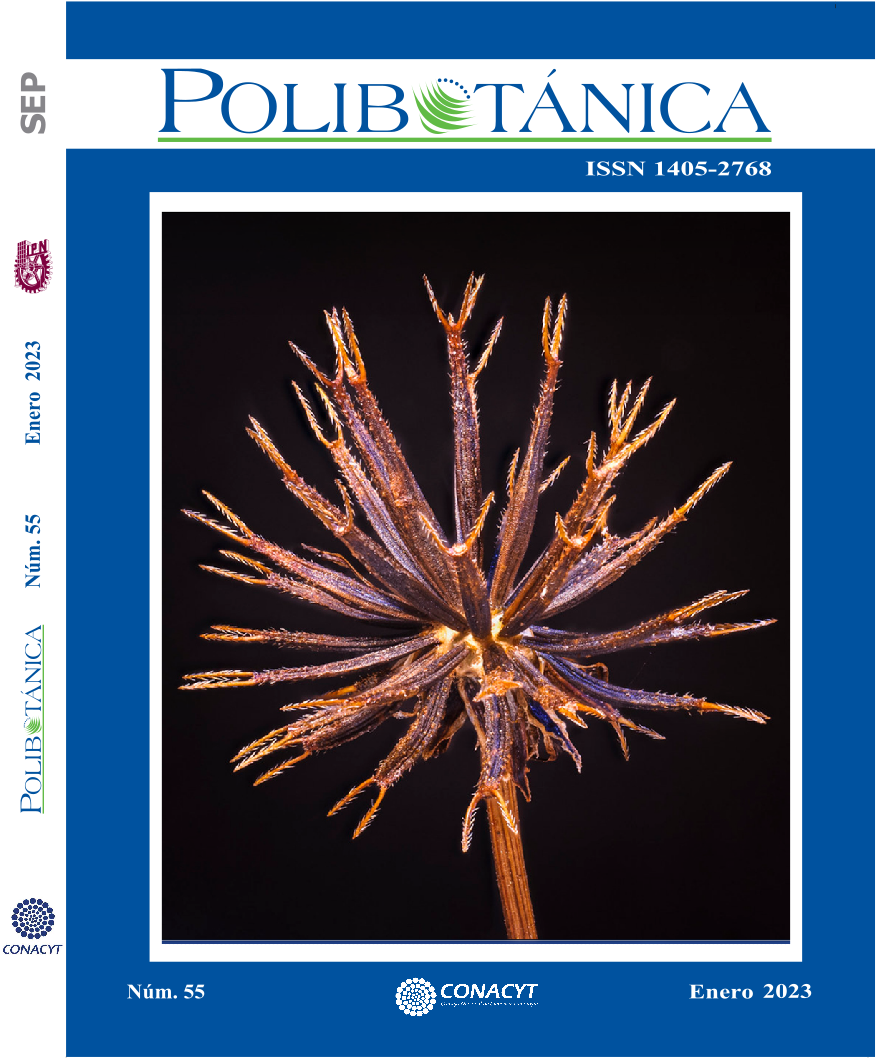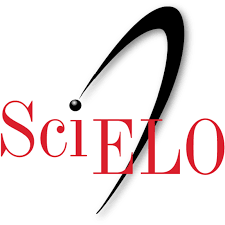16. In vitro evaluation of the antibacterial efect of extracts of Bidens pilosa L. and Eryngium foetidum L
DOI:
https://doi.org/10.18387/polibotanica.55.8Keywords:
Bidens pilosa, Eryngium foetidum, antibacterial activity, phytochemical screeningAbstract
The objective of the study was to evaluate the in vitro antimicrobial effect of the ethanolic extracts of Bidens pilosa and Eryngium foetidum on Staphylococcus aureus, Escherichia coli and Salmonella Typhimurium. The highest yield percentage was with Bidens pilosa leaves (1.3±0.12) and for Eryngium foetidum (0.21±0.04%) in the month of November. Preliminary phytochemical analysis revealed the presence of some secondary alkaloid metabolites, glycosides, saponins, sterols, flavonoids, and tannins. Concentrations of 5, 10 and 15 mg/ml were evaluated in 98% ethanol dilution. The Minimum Inhibitory Concentration (MIC) will be prolonged by means of the diffusion method and dilution in agar. The bacterial inoculum was standardized at 0.5 of the MacFarland scale in a spectrophotometer, obtaining as a result that the concentrations of 15 mg/ml did not present inhibition halos, being the concentration at 10 mg/ml of Eryngium foetidum extract the one that presented the greatest halo. of inhibition (21.0 ± 2.0) for Staphylococcus aureus. In the Minimum Bactericidal Concentration (MBC) concentrations of 250, 125, 62.5 and 31.25 mg/ml were evaluated, the CMB was presented from the concentration of 15.62 for Staphylococcus aureus with Eryngium foetidum while the highest concentration was obtained for Bidens pilosa with 125 mg/ml in Escherichia coli and Salmonella Typhimurium. The antimicrobial susceptibility test shows that all concentrations appeared antimicrobial susceptibility. On the other hand, the results for Eryngium foetidum show the minimum concentration of 62.5 mg/ml in the strain of E. coli and Salmonella Typhimurium
References
Arroyo, J., Bonilla, P., Ráez, E., Barreda, A., & Huamán, O. (2010). Efecto quimioprotector de Bidens pilosa en el cáncer de mama inducido en ratas. Anales de La Facultad de Medicina, 71(3), 153–159. http://www.scielo.org.pe/scielo.php?pid=S1025-55832010000300003&script=sci_abstract
Bauer, R., & Wortzel, L. (1966). Doctor’s choice: The physician and his sources of information about drugs. Journal of Marketing Research, 3(1), 40–47. https://www.jstor.org/stable/3149433
Begum, S., Ahmaruzzaman, M., & PradipAdhikari, P. (2018). Ecofriendly bio-synthetic route to synthesize ZnO nanoparticles using Eryngium foetidum L. and their activity against pathogenic bacteria. Materials Letters, 228, 37–41. https://doi.org/10.1016/j.matlet.2018.05.091
Cruz, A., Rodríguez, N., & Rodríguez, C. (2010). EVALUACIÓN IN VITRO DEL EFECTO ANTIBACTERIANO DE LOS EXTRACTOS DE Bidens pilosa, Lantana camara, Schinus molle Y Silybum marianum. Rev. U.D.CA Act. & Div. Cient, 13(2), 117–124. http://www.scielo.org.co/scielo.php?pid=s0123-42262010000200014&script=sci_abstract&tlng=es
de Oliveira, A., & Martins, C. (2022). Actividade antimicrobiana de extratos vegetais de especiarias do norte do Brasil. Research, Society and Development, 11(2), 1–9. DOI: http://dx.doi.org/10.33448/rsd-v11i2.26047
Delgado, J., Sánchez, M., & Bonilla, C. (2016). Efecto del secado y la edad de las plantas en la composición de los aceites esenciales de Lippia alba (Mill.) N.E.Br. ex Britton & P. Wilson y Lippia origanoides Kunth. Acta Agronómica, 65(2), 170–174. http://www.scielo.org.co/scielo.php?script=sci_arttext&pid=S0120-28122016000200010
FAO. (2020). Antimicrobial Resistance. Food and Agriculture Organization of the United Nations. [Consultado Abril de 2020]. Disponible En: Http://Www.Fao.Org/Antimicrobial-Resistance/Background/What-Is-It/En/.
Gallegos. Maritza. (2016). Las plantas medicinales: principal alternativa para el cuidado de la salud, en la población rural de Babahoyo, Ecuador. Anales de La Facultad de Medicina, 77(4), 327–331. http://www.scielo.org.pe/scielo.php?script=sci_arttext&pid=S1025-55832016000400002
Grupo Especial de Coordinación Interorganismos sobre Resistencia a los Antimicrobianos. (2019, April). No Podemos Esperar: Asegurar El Futuro Contra Las Infecciones Farmacorresistentes. Documento de Debate Del IACG.
Hemachandra, G., Thuvaragan, S., & Vinotha, S. (2021). Pharmacological screening of Eryngium foetidum Linn – A Review. Borneo Journal of Pharmacy, 4(4), 248–259. DOI: 10.33084/bjop.v4i4.2377
León, M., Osorio, F., & Martínez, U. (2015). Comparación de dos métodos de extracción del aceite esencial de Citrus sinensis L. Revista Cubana de Farmacia, 49(4), 742–750. https://www.medigraphic.com/pdfs/revcubfar/rcf-2015/rcf154n.pdf
Lingaraju, D., Sudarshana, M., Mahendra, C., & Poornachandra, K. (2016). Phytochemical Screening And Antimicrobial Activity Of Leaf Extracts Of Eryngium Foetidum L. (Apiaceae. Indo American Journal of Pharmaceutical Research, 6(2), 4339–4344. https://www.researchgate.net/publication/319527644
Malik, T., Kumar, D., Roy, P., & Okram, A. (2016). Evaluation of Phytochemicals, Antioxidant, Antibacterial and Antidiabetic Potential of Alpinia galanga and Eryngium foetidum Plants of Manipur (India). Pharmacognosy Journal, 8(5), 459–464. DOI:10.5530/pj.2016.5.8
Oladipupo, A., Kehinde, O., Segun, K., Adetayo, A., Mthokozisi, B., Rebamang, A., & Andy, O. (2015). In vitro Antibacterial Activity of Aqueous Extracts of Bidens pilosa L. (Asteraceae) from Nigeria. British Microbiology Research Journal, 8(4), 525–529. https://www.researchgate.net/publication/277326990
OMS. (2013). Estrategia de la OMS sobre medicina tradicional 2014-2023. (Http://Www.Who.Int/about/Licensing/Copyright_form/En/Index.Html).
Panda, S., Mohanta, Y., Padhi, L., & Luyten, W. (2019). Antimicrobial activity of select edible plants from Odisha, India against food-borne pathogens . LWT - Food Science and Technology, 113(1), 175–184. DOI: 10.1016/j.lwt.2019.06.013
Paul, J. H. A., Seaforth, C. E., & Tikasingh. T. (2011). Eryngium foetidum L.: A review. Fitoterapia , 82(3), 302–308. https://doi.org/10.1016/j.fitote.2010.11.010
Pimentel, E., Castillo, D., Quintana, M., Maurtua, dora, Villegas. León, & Díaz, C. (2015). Efecto antibacteriano de extractos etanólicos de plantas utilizadas en la tradiciones culinarias andinas sobre microorganismos de la cavidad bucal. Rev Estomatol Herediana, 25(3), 268–275. http://www.scielo.org.pe/scielo.php?pid=S1019-43552015000400004&script=sci_abstract
Singh, G., Passsari, A., Singh, P., Leo, V., Subbarayan, S., Kumar, B., Singh, B., Lalhlenmawia, H., & Kumar, N. (2017). Pharmacological potential of Bidens pilosa L. and determination of bioactive compounds using UHPLC-QqQLIT-MS/MS and GC/MS. BMC Complement Altern Med., 17(1), 492. doi: 10.1186/s12906-017-2000-0
Downloads
Published
Issue
Section
License

Polibotánica by Departamento de Botánica de la Escuela Nacional de Ciencias Biológicas del Instituto Politécnico Nacional se distribuye bajo una Licencia Creative Commons Atribución-NoComercial-CompartirIgual 4.0 Internacional.




















